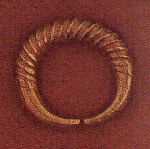Irish Coinage
____________________
EARLY COINS
The Earliest Currency in Ireland
This page contains information and links relating to currency in Ireland before 995 AD.
Index:
On this Page:
Related
Pages :
© 2003 - Copyright
John_Stafford-Langan
Version 1.11a
22nd June, 2003
Celtic Exchange and Ring Money

Several Pieces of Celtic Ring Money
Pre Christian Ireland had a very precise set of laws which usually involved a payment by the perpetrator of a crime to the victim or the victim's family. The punishment for default was death. The records of these laws (mostly dating from christian era documents) state that slaves and cattle were an accepted medium of large exchange. Presumably smaller exchanges were made on a similar basis with tools and ornaments.
There are a number of gold and gold plated rings found in Irish and other celtic contexts referred to as 'ring money'. The variation in the quality and standard of these pieces does not suggest a fixed denomination but rather that these items were used like hack silver and assayed at every exchange. The gold plated pieces are a problem in this context as they do not seem to be likely to have been made in imitation of solid pieces nor would they have been easy to assay.
Hoards of Irish celtic
gold ornaments often consist of quantities of cloak
fasteners suggesting that these items were used as a
medium of exchange rather than just for fastening cloaks.
But as with the ring money there is no evidence for a
fixed series of weights and measures being used in their
manufacture.
Greek and Roman Influence

Reverse of gold stater of Philip II of Macedonia
struck at the Pella mint in about 345 BC
The earliest coinage which affected the North West of Europe was the Macedonian coinage of Philip II and Alexander III (the Great). This extensive coinage became the model for many of the crude copies produced by the celts of Germany, France and Southern England. There is no evidence that the celts in Ireland struck their own copies of this currency but the English and continental coins are occasionally found in Ireland.
The Roman conquest of Europe extended to England but not fully to Ireland although an encampment north of Dublin was briefly established in the first century AD. Roman coins are found in an Irish context but mostly mixed with other ornaments and hack silver indicating that the coinage was not acknowledged as a medium of exchange at a set value but rather as another piece of precious metal to be assayed at every exchange. In support of this theory it is interesting to note that the Roman coins found in Ireland are most often of silver or gold and rarely the copper pieces which are found in large quantities in the rest of 'Roman Europe'.
During the 'Dark Ages' in Europe, after the fall of the Roman empire, few coins were in use in Ireland on the basis of the hoard evidence. However, metalwork was at a very high level of skill and quality and many hoards of silver and gold ornaments have been found. It is normally assumed that any coin that arrived in Ireland was quickly melted and used to manufacture such ornaments.
To view larger images of the
gold stater (above) select the OBVERSE or REVERSE (about 70 Kb each) with a scale in
centimetres.
Coinage for External Trade

Obverse of a silver dirham of Caliph Mansur
struck in Baghdad, dated 156 AH (773 AD)
From about 600 AD coins do begin to turn up again in Irish hoards but mostly, as in Roman times, in a context that suggests little distinction is made between struck silver and other worked precious metals.
Some hoards do occur of English pennies and (occasionally) early Islamic dirhams from about 800 AD. These hoards are usually in a context that suggest that they were for use in trade across the Irish Sea with England or Wales.
Even after the Viking settlements were established in Dublin and Limerick and when Danish and English coins were in use in these settlements there is evidence that the coinage, when it did get into Irish hands, was either melted or used in return trade with the Vikings.
There is no evidence that the native Irish made use of coins except for external trade before the arrival of the Normans in 1169.
To view larger images of the
dirham above select the OBVERSE or REVERSE (about 70 Kb each)